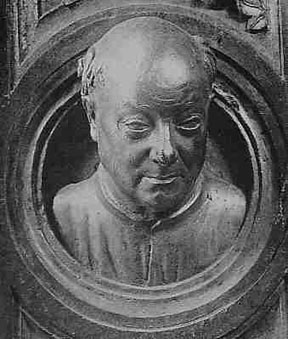| Lorenzo Ghiberti  Born: c. 1378 Born: c. 1378
Birthplace: Pelago, Italy
Died: 1-Dec-1455
Location of death: Florence, Italy
Cause of death: unspecified
Remains: Buried, Santa Croce Church, Florence, Italy
Gender: Male
Religion: Roman Catholic
Race or Ethnicity: White
Sexual orientation: Straight
Occupation: Sculptor Nationality: Italy
Executive summary: Cast the Florence Baptistery doors Italian sculptor, born at Florence in 1378. He learned the trade of a goldsmith under his father Ugoccione, commonly called Cione, and his stepfather Bartoluccio; but the goldsmiths art at that time included all varieties of plastic arts, and required from those who devoted themselves to its higher branches a general and profound knowledge of design and coloring. In the early stage of his artistic career Ghiberti was best known as a painter in fresco, and when Florence was visited by the plague he repaired to Rimini, where he executed a highly prized fresco in the palace of the sovereign Pandolfo Malatesta. He was recalled from Rimini to his native city by the urgent entreaties of his stepfather Bartoluccio, who informed him that a competition was to be opened for designs of a second bronze gate in the baptistery, and that he would do wisely to return to Florence and take part in this great artistic contest. The subject for the artists was the sacrifice of Isaac; and the competitors were required to observe in their work a certain conformity to the first bronze gate of the baptistery, executed by Andrea Pisano about 100 years previously. Of the six designs presented by different Italian artists, those of Donatello, Filippo Brunelleschi and Ghiberti were pronounced the best, and of the three Brunelleschi's and Ghiberti's superior to the third, and of such equal merit that the thirty-four judges with whom the decision was left entrusted the execution of the work to the joint labor of the two friends. Brunelleschi, however, withdrew from the contest. The first of his two bronze gates for the baptistery occupied Ghiberti twenty years.
Ghiberti brought to his task a deep religious feeling and the striving after a high poetical ideal which are not to be found in the works of Donatello, though in power of characterization the second sculptor often stands above the first. Like Donatello, he seized every opportunity of studying the remains of ancient art; but he sought and found purer models for imitation than Donatello, through his excavations and studies in Rome, had been able to secure. The council of Florence, which met during the most active period of Ghiberti's artistic career, not only secured him the patronage of the pontiff, who took part in the council, but enabled him, through the important connections which he then formed with the Greek prelates and magnates assembled in Florence, to obtain from many quarters of the Byzantine empire the precious memorials of old Greek art, which he studied with untiring zeal. The unbounded admiration called forth by Ghiberti's first bronze gate led to his receiving from the chiefs of the Florentine guilds the order for the second, of which the subjects were likewise taken from the Old Testament. The Florentines gazed with especial pride on these magnificent creations, which must still have shone with all the brightness of their original gilding when, a century later, Michelangelo pronounced them worthy to be the gates of paradise. Next to the gates of the baptistery Ghiberti's chief works still in existence are his three statues of St. John the Baptist, St. Matthew and St. Stephen, executed for the church of Or San Michele. In the bas-relief of the coffin of St. Zenobius, in the Florence cathedral, Ghiberti put forth much of his peculiar talent, and though he did not, as is commonly stated, execute entirely the painted glass windows in that edifice, he furnished several of the designs, and did the same service for a painted glass window in the church of Or San Michele. He died at the age of 77.
We are better acquainted with Ghiberti's theories of art than with those of most of his contemporaries, for he left behind him a commentary, in which, besides his notices of art, he gives much insight into his own personal character and views. Every page attests the religious spirit in which he lived and worked. Not only does he aim at faithfully reflecting Christian truths in his creations, he regards the old Greek statues with a kindred feeling, as setting forth the highest intellectual and moral attributes of human nature. He appears to have cared as little as Donatello for money.
Benvenuto Cellini's criticism on Ghiberti that in his creations of plastic art he was more successful in small than in large figures, and that he always exhibited in his works the peculiar excellences of the goldsmith's quite as much as those of the sculptor's art, is after all no valid censure, for it merely affirms that Ghiberti faithfully complied with the peculiar conditions of the task imposed upon him. More frequent have been the discussions as to the part played by perspective in his representations of natural scenery. These acquired a fresh importance since the discovery of the data, from which it appeared that Paolo Uccello, who had commonly been regarded as the first great master of perspective, worked for several years in the studio or workshop of Ghiberti, so that it became difficult to determine to what extent Uccello's successful innovations in perspective were due to Ghiberti's teaching.
Father: Cione Ghiberti (father or stepfather)
Father: Bartolo di Michele (father or stepfather)
Wife: Marsilia (dau. of woolmaker Bartolomeo di Luca)
Son: Tommaso (b. 1417)
Son: Vittorio (b. 1418)
Author of books:
I Commentarii (1447, art history)
Do you know something we don't?
Submit a correction or make a comment about this profile
Copyright ©2019 Soylent Communications
|